- Aggregate Demand - a schedule
that shows how much goods and services people want to buy and the price
level
- Total goods and services is GDP
- Price level - index of all prices for final goods and
services
- AD Function has a negative slope
- Not a demand function!
- Why the negative slope?
- Real balance effect - the
value of people's money, savings and investment after adjusting for
inflation
- A high price level results from inflation
- Inflation - price level is increasing
- Inflation reduces the value of money, savings, and investments
like stocks and bonds
- At a lower price level, people have a higher real balance
effect and spend more on goods and services
- Interest rate effect - more
complicated
- Money in economy is fixed (until central bank increases it)
- At higher price levels, people lower the amount of savings to
financial institutions
- Interest rates have to be high to attract funds
- i.e. Fisher Equation
- At higher interest rates, businesses and people invest less in
structures, machines, and equipment
- Lower GDP
- Note - The price level impacted interest
rates
- Foreign purchases effect -
how one country's price level compares to another country
- The U.S. price level increases relative to another
country
- Exchange rates did not change; price level impacts
exports and imports directly
- Americans increase imports, because they are cheaper
- Foreigners decrease exports, because they are more
expensive
- Aggregate Demand is shown below
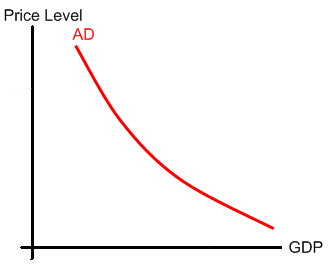
- Shifts in Aggregate Demand
- Consumers
- Consumer spending - consumers decide to save less income and
consume more, thus increasing (shifting right) the aggregate demand
function
- Real Wealth - if consumers wealth increases, consumers spend more,
aggregate demand shifts right
- Stock prices dropped significantly during 2008
- People have lower wealth because pension plans and investments
are lower in value
- Aggregate demand shifts left
- Consumer expectations
- If consumers are optimistic about the future, they may spend
more now, increasing aggregate demand
- If consumers are pessimistic about the future, they may reduce
their spending
- If a consumer is expecting layoffs, a tough job market, etc.,
he is more likely to reduce spending and increase
savings
- Household debt -
- If households have low debt, they can increase their spending by
borrowing more, causing aggregate demand to shift right
- If households have high debt, they may lower their spending in
order to pay it back, decreasing aggregate demand
- Taxes
- Government increase taxes, disposable income falls, so
households have to consume and save less, AD shifts left
- Government decreases taxes, disposable income increase, so
households can consume and save more, thus, AD shifts
right
- Investment
- Real interest rates
- Households - invest in more new houses, new cars, and
appliances, when real interest rates are low
- Not caused by a change in price level
- Businesses - invest in more structures, machines, and equipment
- AD increases and shifts right
- Expected Returns (or Profits) - businesses invests more if they
expect future profits
- Businesses are optimistic about the future business climate
- Economy is growing along with consumers' demands
- Businesses adopt new technologies
- Technology lowers production costs, increases workers'
productivity, or increases quality
- Businesses are using their capital at full capacity
- Businesses invest in more capital in order to increase the
capacity level
- Taxes - if government decreases taxes, then businesses may
invest more
- Government - government is a large sector of economy
- If government increases spending, then AD increases and shifts
right
- If government decreases spending, then AD decreases and shifts
left
- International sector
- Not caused by a change of the price level
- If net exports increase
- Either exports increase and/or imports decrease
- More products and services are produced here and exported,
causing AD to shift right
- Foreign income - if a foreign country becomes richer, they import
more
- Our exports increase, causing AD to shift right
- Exchange rates
- If U.S. dollar appreciates (or becomes stronger), then
- Exports decrease
- Imports increase
- AD shifts left
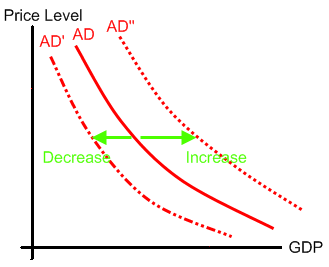
|
|
Aggregate Supply - a schedule that
shows the amount of goods nd services producers manufacture at each price
level
- Short run - prices for some
resources do not change immediately to changes in the price level
- Long run - prices for all
resources change immediately to price level changes
- Short-run aggregate supply has
positive slope
- If the price level increases but wages do not change, companies
can produce more goods and services
- The total value of goods and services are higher, because the
price level is higher
- Wages are stuck at the same level, so firms earn profits when
expanding output
- Short-run aggregate supply is shown below
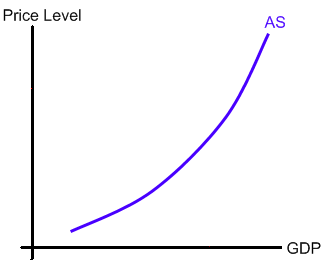
- Long-Run Aggregate Supply - all resource prices increase with the
price level
- Workers wages rise with the cost of inflation
- Long-run aggregate supply is a vertical line
- Country produces at that level of GDP regardless of the price
level
- Is this correct? Remember hyperflation?
- Long-run aggregate supply is shown below
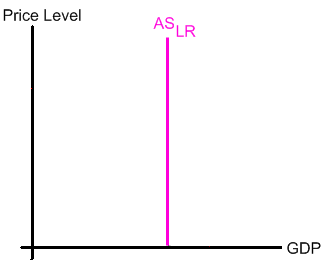
Shifts in Aggregate Supply
- Input Prices
- Labor - largest expense for businesses
- Immigration - if many new workers enter the market, wages tend
to fall
- Labor costs are cheaper and AS shifts right
- Part of the labor retires, supply of workers decreases and wages
tend to increase
- Labor becomes more expensive and AS shifts
left
- Capital like machines, equipment, and structures
- Price of capital decreases, businesses invest more, causing AS
to increase
- If capital from foreign countries becomes cheaper, businesses
import and invest more
- Materials
- If resources used for inputs become cheapter, then firms expand
production, causing AS to increase
- More petroleum or mineral deposits are discovered, then prices
for these products tend to fall
- If resources from foreign countries becomes cheaper, firms use
more and import more
- Market Power - an industry with market power can impact whole
economy
- OPEC sets production quotas on petroleum, causing petroluem
price to increase
- Petroleum is used in many products and transportation, raising
prices for everything in the economy
- AS decreases and shifts and left
- Productivity - firms produce a
level of output given that it uses labor to make the output
- Increases in productivity is where firms are able to make more
output given the same level of labor
- Adopted new technology
- Workers become more productive over time
- Productivity increases approximately 2% per year in U.S.
- AS increases and shifts right
- Legal environment - government has a large impact on businesses
- If government changes legal structure that lowers businesses'
production costs
- Government lowers business taxes
- Improved property rights
- Government reduces regulations
- Reduce bureaucratic red tape
- Government increases subsidies
- AS increases and shift right
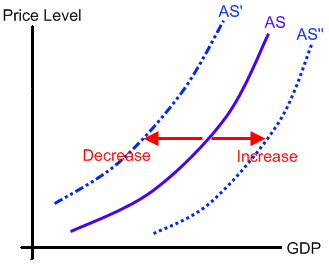
|
|
Equilibrium - state of rest; nothing changes
- Price level and level of GDP do not change
- At P', businesses and producers produce at Q1 while
consumers want to buy Q2
- Consumers bid up prices until the price level is at
P*
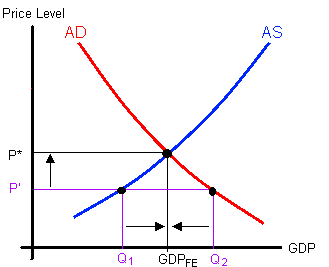
- At P" businesses and producers produce at Q2 but
consumers want to buy Q1
- Inventories are increasing
- Businesses reduce prices to sell inventories and cut back on
production
- Price level falls until it equals P*
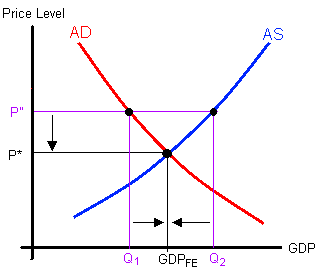
Case 1 - AD increases and shifts right
- Businesses increase investment
- Government increases spending or lowers income taxes
- If the economy was at full employment (FE) and AD increases
- GDP increases
- Price level increases
- Creates Demand Pull Inflation
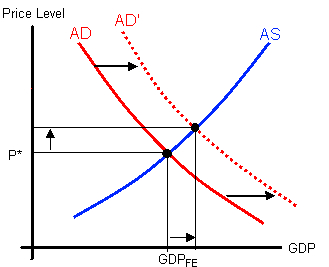
Case 2 - AD decreases and shifts left
- Business investment decreases
- Government decreases spending (not typical)
- Government increases taxes on incomes
- Note - prices in an economy tend not to decrease
- If prices could fall (deflation), then economy is in a recession
at Q1
- If prices do not fall, then economy is in a recession at
Q2
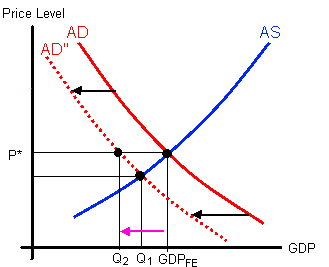
- Why prices do not fall?
- Companies do not want to start a price war
- Price wars destroy profits, as companies keep trying to under
cut each other
- Menu costs - changing prices
imposes additional costs on companies
- If firms believe recession will be short live, they may not
lower their prices
- Menu costs
- Cost of printing new catalogs, menus, etc.
- Cost to re-price merchandise that is in inventory
- Cost to communicate prices to consumers
- Consumers get angry if prices change suddenly or
unexpectedly
- Labor is a major cost and firms may not be able to lower workers'
wages
- Wage contracts - companies and workers agreed to wages specified
in a contract
- Efficiency wages - wages
reflect a worker's level of productivity
- Lowering wages may decrease workers' morale and work habits,
potentially lowering workers' productivity
- Minimum wage laws - firms cannot lower wages below the minimum
wage
Case 3 - AS decreases and shifts left
- War
- Natural disaster
- Energy price shock
- Leads to lower output and a higher price level
- Cost Push inflation
- Stagflation
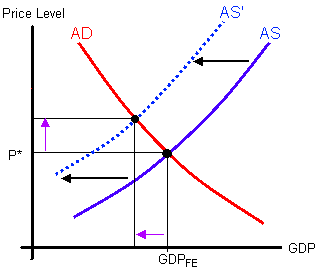
Case 4 - AS increases and shifts right
- Producers adopt new technology
- Increased immigration, which lowers wages
- Output increases
- If prices could fall, then economy grows to Q1
- If prices are rigid, then economy grows larger to Q2
- Prices may not fall because of the reasons for Case
2
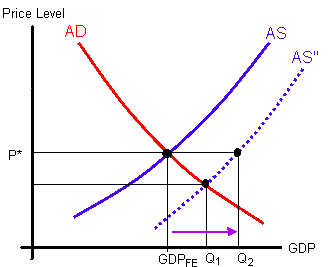
 |
If an economy has rigid prices, where prices cannot fall, then
changes can have a much larger impact on the
economy. | |











